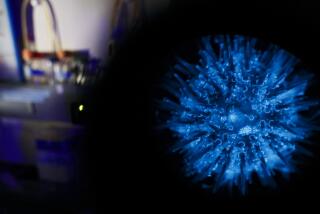CRISPR revolutionized gene editing. Now its toolbox is expanding
- Share via
The gene-editing tool that has revolutionized biology is becoming even more powerful.
CRISPR, as the system is known, allows scientists to target and snip a specific sequence of letters on a strand of DNA with unprecedented precision. That has opened up new possibilities for treating genetic diseases, helping plants adapt to global warming and even preventing mosquitoes from spreading malaria.
CRISPR is made up of two basic components. The first is a piece of RNA that locates a predetermined sequence of DNA in an organism’s genome that scientists want to alter. The second is a type of protein called an enzyme that attaches itself to the target section of DNA and splices it.
Cas9 has been the workhorse enzyme because it executes a neat, blunt cut. But in the last few years, scientists have started to search for — and find — alternative CRISPR systems that cut with enzymes other than Cas9.
“Cas9 is a powerful tool, but it has limitations,” said CRISPR pioneer Feng Zhang, a bioengineer at MIT and the Broad Institute. “Each of these proteins has shortcomings and strengths, and together they help us create a much more versatile box of tools.”
Some of the new Cas enzymes cut DNA in different ways that make certain edits more likely to work. Other enzymes are smaller, allowing scientists to more easily insert them into cells.
“The diversity of CRISPR proteins is exceptionally broad,” said Benjamin Oakes, an entrepreneurial fellow at the Innovative Genomics Institute, a joint project of UC Berkeley and UC San Francisco. “They have been evolving over millennia and nature has developed hundreds, if not thousands, that can work.”
In nature, bacteria use this technology as a defense mechanism to find and destroy attacking viruses.
Bacteria store sequences of viral DNA within their own DNA, bookended by a repeating sequence of letters. Hence the system’s name CRISPR, which stands for Clustered Regularly Interspaced Short Palindromic Repeats. (The first CRISPR systems discovered were indeed partly palindromic, however scientists later found that that this is not universally true.)
CRISPR-Cas9 has already proved to be an exceedingly useful tool for a wide variety of genetic tinkering, including turning genes on and off, disabling them entirely, introducing new DNA into a genome, and deleting DNA you don’t want.
But scientists wondered what other CRISPR enzymes might bring to the genetic editing table.
CRISPR-Cas12a was the first system after CRISPR-Cas9 to be used for gene editing in the lab. A recent study on Cas12a’s cousin Cas12b demonstrated that this variant could edit the human genome as well, giving scientists yet another tool to tackle genetic diseases.
Other work has shed light on a suite of additional promising CRISPR enzymes, including Cas13, Cas14 and CasY. The latest candidate, CasX, was described in detail Monday in a study by Oakes and others in the journal Nature.
Comparing CRISPR systems is a bit like comparing fruits, Zhang said. If Cas9 enzymes are apples, then Cas12 enzymes might be plums — still edible and delicious, but also totally different.
And like fruit, these different systems have variations within them. Just like there are subspecies of plums, there is also a wide variety of Cas12 enzymes.
These differences play out in several ways. For example, unlike CRISPR-Cas9, which cuts both strands of DNA in the same spot, CRISPR-Cas12a and the CRISPR-CasX make what is called a staggered cut, so that the two strands are severed in different places.
There is evidence that a staggered cut makes it more likely that a cell will accept a new piece of DNA at the site of the splice, said Thomas Clements, a geneticist at Vanderbilt University in Nashville. So if the goal is to add DNA to a cell, a system that uses Cas12a, and perhaps one day CasX, might be a better choice than Cas9, he said.
The sizes of the different CRISPR proteins also vary. Within the Cas9 family, there are enzymes made up of 1,350 nucleotides (the basic structural unit of DNA) and others that contain only 1,000 nucleotides. CasX and Cas12a are smaller still.
Size is an important criterion because smaller molecules are easier to get into cells than larger ones, said Eugene Koonin, who studies evolutionary genomics at the National Institutes of Health.
“In a sense, there is a race to come up with the smallest efficient genome editor so you can combine it with other things that you can pack into a viral vehicle” for delivery inside a cell, he said. “Size is critical.”
The hunt for Cas9 alternatives has scientists scouring the planet.
Jillian Banfield, a geomicrobiologist at UC Berkeley, found CasX and CasY embedded in the DNA of bacteria that inhabit underground aquifers.
One of the earliest known forms of Cas12b was discovered in the clean room where NASA’s Viking spacecraft was assembled.
Banfield said scientists are also sampling organisms that inhabit lakes, rivers and marine environments, as well as sites hundreds of feet below the Earth’s surface, to see what inventive gene editors bacteria there might be harboring.
“We are exploring the full diversity of Earth’s habitable environments so that we can sample organisms across the tree of life,” she said.
There are already thousands of known Cas9 variants and even more Cas12 variants that still need to be studied and characterized. There are also researchers who are tinkering with the known CRISPR systems to make them more effective.
“There is a lot of opportunity to explore how we might be able to augment the CRISPR toolbox,” Feng said. “The more options people have, the more likely it is that we can treat as many diseases as possible.”
Do you love science? I do! Follow me @DeborahNetburn and “like” Los Angeles Times Science & Health on Facebook.
MORE IN SCIENCE






